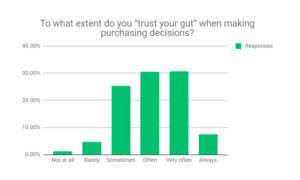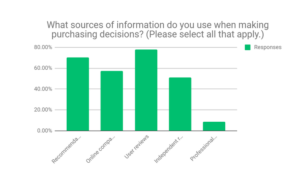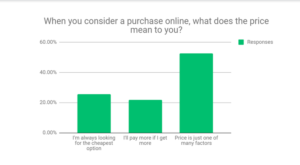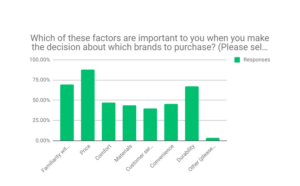Surprising New Survey Shows Most Customers “Trust Their Gut” When Making Purchasing Decisions

Three major surprises emerged in the recent in-depth survey of purchasing decisions by a representative sample of 1,010 US citizens by Top10.com.
First, the survey turns on its head the common theory of the “rational consumer.” Colleges teach students this theory as a basis for all of their business education. Many people go on to use this theory to run their businesses. However, some recent research in behavioral economics and cognitive neuroscience has been questioning this assumption.
The Top10 survey further supports the criticism of the “rational consumer” theory by showing that people don’t shop with their heads, they shop with their gut. Over two-thirds of respondents reported that they “trust their gut” often, very often, or always when making shopping decisions. So the large majority of people don’t fit the outdated theory. No wonder that half of all new businesses fail in the first 5 years or that most product launches flop: business leaders use the wrong framework to approach consumers.
Second, the Top10 survey shows the outdated nature of the widely prevalent assumption that word of mouth offers the best way of marketing and selling a product. In the past, recommendations from friends and family mattered much more than anything else, at 90% according to a 2012 HubSpot survey.
However, in 7 short years, the landscape changed. The 2019 Top10 survey highlights how recommendations from friends matter much less, dropping to 70%, and information from online sources such as user reviews has grown much more important, topping friend recommendations. Marketers and business leaders need to update their beliefs about what matters to shoppers to succeed in the new digital age.
Third, the Top10 survey breaks new ground on consumer price sensitivity. While many assume that price is the most important factor by far, the survey shows they’re wrong. In fact, only a quarter of respondents go for the cheapest option. Over half consider price as one of many factors.
Next, we’ll dive deeper into the survey findings on these three surprising results.
Consumers Go With Their Gut in Purchasing Decisions


Consumers, by and large, trust their gut when making shopping choices. Less than one third – specifically 31% percent – rely on their gut only sometimes, rarely, or not at all to make the right choice. By contrast, 69% rely on their gut often, very often, or always.
The large majority of shoppers choosing to rely on their gut is unfortunate for the sake of making wise purchasing decisions. We know that we are all vulnerable to unconscious dangerous judgment errors that scholars in behavioral economics and cognitive neuroscience call cognitive biases. These are the mental blindspots that lead people away from being the idealized rational consumers of classical economic theory, always focusing on their own best long-term interest when making shopping decisions.
Cognitive biases come mainly from relying on our gut reactions – our emotions and intuitions – to make decisions. It’s not only shopping: our emotions determine 80-90% of our thoughts, behaviors, and decisions in all life areas. In fact, people with brain damage that impairs their ability to process emotions have a great deal of difficulty making all sorts of decisions.
Now, emotions undoubtedly have a key role to play in shopping. After all, the large majority of what we buy is not meant to satisfy basic, primary needs like clothing and shelter. Instead, it satisfies our wants and desires and comes from our personal lifestyle and values, our tastes and preferences. Some people like chocolate ice cream, and some like vanilla; some people want to live in the big city, and some in the suburbs; some like Apple and some PC. As people say, there’s no arguing with taste, and our emotions determine our tastes.
The mistakes we make come from how we try to satisfy our tastes and preferences. For example, most consumers believe that more options would make them happier with both the process and outcome of their shopping. Yet in reality, it’s not true.
Having some choices makes us feel good, yet once we get beyond that small number, we feel less and less happy the more choices we get. The trick is that we tend to buy into the (false) concept that more choices will make us feel better.
For instance, in one study, shoppers at a fancy food market—not a lab—saw a display table with free samples of 24 varieties of gourmet jam. On another day, in the same market, shoppers saw a display table with 6 jam varieties. You won’t be surprised that the larger display attracted substantially more interest. However, people who saw the smaller selection were 10 times more likely to buy the jam, and felt better about themselves doing so than those who had to select among 24 varieties.
The problem here is a cognitive bias called loss aversion. Our gut reactions prefer avoiding losses to making gains. Thus, we want way too many choices, wrongly perceiving a limited number of choices as losing out, despite the real loss coming from less happiness.
Let’s take another example. Don’t you like it when you have the option to return what you bought if you didn’t like it? Well, another counterintuitive behavioral economics finding shows that, while we have a preference for being able to refund our purchases, we feel more satisfied with a shopping decision if it’s nonreversible.
As an example, in one study, students got to choose between 2 art posters. Half the students were not allowed to change their mind, while the other half were told they could exchange the poster they chose for another one in the next 30 days. While 66% preferred to be in the half of the group that could change their minds, later evaluations showed that those who couldn’t exchange their posters actually were substantially happier with their decision. The culprit here is a judgment error called choice-supportive bias, where we become happier with a choice after we committed to it, rather than pondering the prospect of returning it.
You might have heard the phrase “keeping up with the Joneses” as referring to our desire to maintain a standard of living comparable to those around us, such as our neighbors, who we consider to be on a similar social level. Popularized by an early 20th century comic strip called “Keeping up with the Joneses,” this idiom points to an important aspect of our shopping behavior.
Our gut intuitions drive us to improve our social status, and the cognitive bias known as the social comparison bias in particular causes us to try to outcompete others in our tribal group through our shopping. Scholars term such status-driven shopping “conspicuous consumption,” referring to buying products not primarily for their actual practical use, but for the prestige value of the purchase in raising the buyer higher in the social hierarchy. Such conspicuous consumption often drives us to make the wrong choices.
Fortunately, savvy consumers – the 1.29% who never simply go with their gut – know that they can make much better decisions to satisfy their tastes and preferences by protecting themselves from intuitive reactions and instead relying on their head.
Recent research in cognitive neuroscience and behavioral economics shows how you can use pragmatic strategies to address these dangerous judgment errors, whether in your shopping, your professional life, your relationships, or other life areas.
You need to evaluate where cognitive biases are hurting you and others in your team and organization. Then, you can use structured decision-making methods to make “good enough” daily decisions quickly; more thorough ones for moderately important choices; and an in-depth one for truly major decisions.
Such techniques will also help you implement your decisions well, and formulate truly effective long-term strategic plans. In addition, you can develop mental habits and skills to notice cognitive biases and prevent yourself from slipping into them.
What Sources Do Consumers Use to Make Purchasing Decisions?
It’s a brave new digital world when supposedly savvy marketers and business publications writing in 2019 still consider word of mouth as the most effective and important marketing technique, while the Top10 survey clearly shows they’re wrong.


Why are they wrong? They’re relying on outdated information.
In 2012, Nielsen ran a survey showing that 92% of survey respondents trusted recommendations from friends and family. In Nielsen’s 2015 survey, only 83% trusted recommendations from family and friends, a substantial drop of about 10% over 3 years. Only 66% trusted consumer opinions posted online, which overwhelmingly come in the form of user reviews.
Top10’s survey shows that in the intervening 4 years, reliance on recommendations from family and friends dropped even further, to 70%. By contrast, the stock of user reviews grew substantially, to 77%, overcoming recommendations from friends and family. Other sources of online information are also catching up to recommendations from friends and family, with online comparison sites used by more than half of Top10 survey respondents?
What explains this change, which apparently has not yet been internalized by many marketers? In part, people’s increasing familiarity and comfort with online information and online shopping as a whole.
Shoppers are increasingly shopping online, with 2016 marking the year when consumers made more of their purchases online, a trend that continues to date. When consumers make online purchases, they often don’t have the opportunity to consult friends and family. They naturally turn to online sources for information, such as online reviews by others and comparison sites.
Another factor explaining this dynamic comes from generational change. As more millenials grow into their full economic potential, and more older people leave this world, trust in online sources of information only grows. The Top10 survey shows that younger people show more trust for online sources such as online reviews and comparison websites compared to older people. Other research from December 2018 shows that 80% of those between 18 and 34 wrote online reviews themselves, while only 41% of those over 55 did so. We’re naturally more invested in the kind of activities we do ourselves.
Unfortunately, many shoppers fall into dangerous judgment errors by trusting user reviews online. Bogus reviews are widespread. It’s easy to buy fake good reviews, while a number of people leave false bad reviews for a variety of reasons. Shoppers tend to focus most on extreme reviews, even though those are least likely to be accurate.
It’s not surprising that research shows that objective ratings produced by high-quality online comparison sites have a low correlation to online user reviews. Due to cognitive biases such as the illusory truth effect – where we tend to believe something that’s repeated often enough regardless of whether it’s true – enough user reviews repeating the same thing, good or bad, often drive us to make bad shopping decisions.
Price Sensitivity in Purchasing Decisions
Too many businesses assume, based on advice by some online marketers, that price dominates consumer choices. The Top10 survey shows that’s just not the case.


Price is not nearly as important as it’s typically depicted. In fact, only a quarter of all consumers – just over 25% in the survey – are bargain hunters. Three quarters are willing to pay more if they are getting more for their money, and consider price as one of many factors.
The confusion in other surveys that trumpet price as the most important factor likely comes from the problematic way they phrase the question. After all, who wouldn’t consider price as an important factor? Many consumers may use price points as the first thing they look at when determining what purchase to make.
To delve more deeply into this question, the Top10 survey asked respondents to list all factors that matter to them when deciding which brand to purchase.


Framing the question this way resulted in price coming out on top as the factor most frequently listed as important.
So price indeed matters, just not nearly as much as typically depicted. The key is to ask how important price is – as the Top10 survey did when asking how much price means to consumers – not simply what factor is most important.
Conclusion
The three major surprises from the Top10 survey show that we need to update our beliefs about how consumers behave. They’re not rational, they’re less price sensitive than we think, and they rely more on – inherently unreliable – online user reviews than recommendations from friends and family. It’s very likely that the trend of increasing reliance on online sources of information will continue, hopefully shifting to more reliable sources such as online review sites. We can also hope that consumers will learn more about making wise decisions when they shop and avoid the dangerous tendency of going with their gut.
Key Takeaway
Consumers mostly make their purchasing decisions with their gut, and make many mistakes. One of these errors is to rely increasingly on online user reviews compared to recommendations from friends, even though user reviews are often misleading.—> Click to tweet
Questions to Consider (please share your thoughts in the comments section)
- When was the last time you made a shopping choice relying on your gut that you regretted?
- Is there anything in the article that will help you make better shopping choices?
- Which next steps will you take based on reading this article?
Adapted version of an article originally published in Top10.com
Image credit: Pixabay/StockSnap
—
Bio: Dr. Gleb Tsipursky empowers you to avoid business disasters as CEO of the boutique consulting, coaching, and training firm Disaster Avoidance Experts. A best-selling author, he wrote Never Go With Your Gut, The Blindspots Between Us, and The Truth Seeker’s Handbook. Tsipursky’s cutting-edge thought leadership was featured in over 400 articles and 350 interviews in Fast Company, CBS News, Time, Scientific American, Psychology Today, Inc. Magazine, and elsewhere. His expertise stems from his background of over 20 years of consulting, coaching, speaking, and training experience across North America, Europe, and Australia. It also comes from his strong research and teaching background in behavioral economics and cognitive neuroscience with over 15 years in academia, including 7 years as a professor at the Ohio State University, with dozens of peer-reviewed academic publications. Contact him at Gleb[at]DisasterAvoidanceExperts[dot]com, follow him on Twitter @gleb_tsipursky, Instagram @dr_gleb_tsipursky, Facebook, YouTube, and LinkedIn. Most importantly, help yourself avoid disasters and maximize success, and get a free copy of the Assessment on Dangerous Judgment Errors in the Workplace, by signing up for his free Wise Decision Maker Guide.

